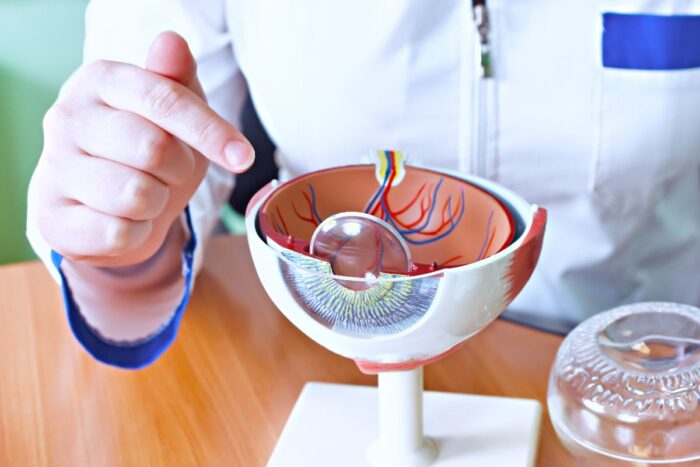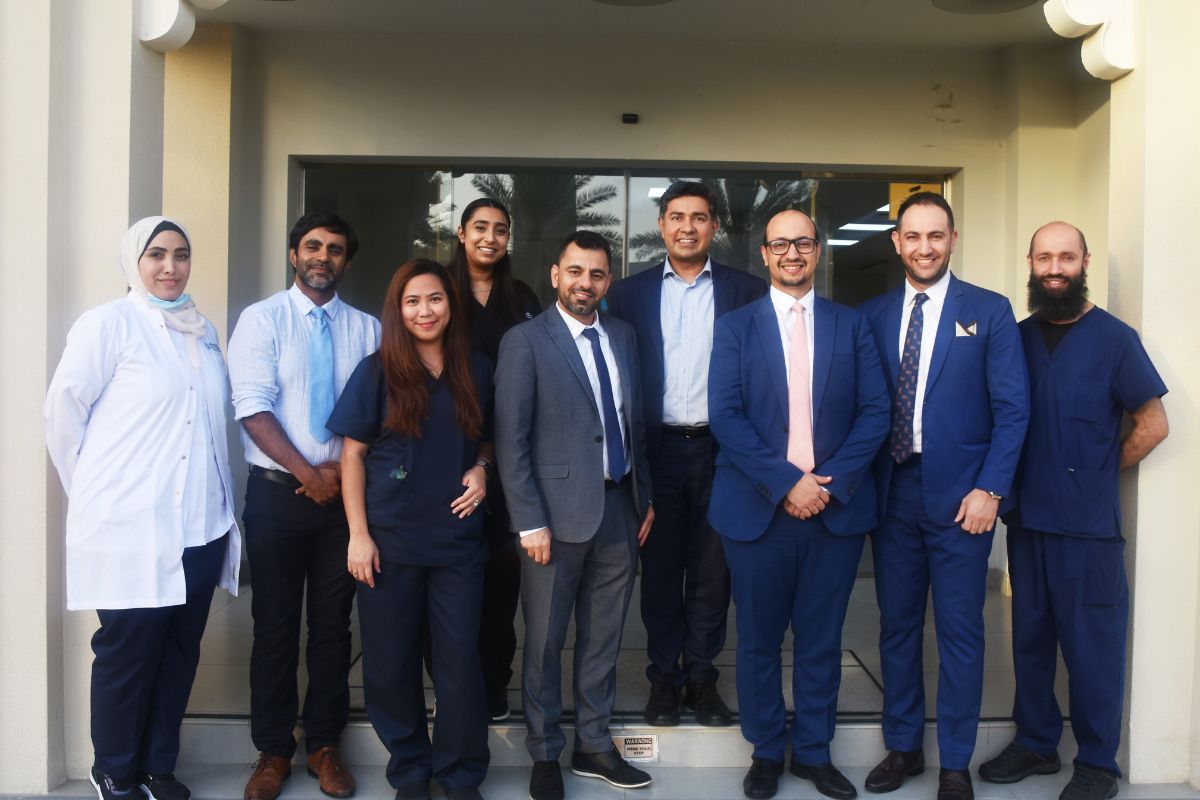
A renowned eyecare hospital that provides world-class medical care to the local population and people throughout the region
Moorfields Eye Hospital London, established over 250 years ago, opened its Abu Dhabi branch in 2016 in collaboration with United Eastern Medical Service, a Mubadala Partner.
Moorfields Eye Hospital Abu Dhabi offers a comprehensive range of eye care services from simple eye tests to complex eye surgeries.
Headed by Dr Esmaeil Arbabi, Medical Director and Consultant Ophthalmologist, Moorfields Eye Hospital Abu Dhabi has world-leading eye care professionals that include specialised ophthalmologists, optometrists and orthoptists, for both children and adults.
“My specialty is basically cataract, corneal transplant and refractive surgery,” he says.
In terms of services, Dr Esmaeil reveals that there is a different variety of subspecialties and doctors who offer surgeries in relation to corneas, cataracts, retinal, glaucoma, to oculoplastic.
“One of the services we are really proud of is Orthokeratology, or ortho-K, which is a very important service since a lot of children are becoming more and more shortsighted,” he says.
“It is one of our differentiating factors at Moorfields Eye Hospital Abu Dhabi and this demonstrates our strong focus on our community as well as prevention.” The hospital also offers a specialist contact lens service, which offers special rigid lens too, a rare service in the UAE. Additionally, there is a special dry eye clinic and a full range of focal refractive services. Eyecare professionals highly recommend visiting an eye specialist regularly to maintain healthy eyes.
Daniel Crown is one of Moorfields Eye Hospital Abu Dhabi’s optometrists, whose role is to assess the vision and focus of the eye.“We discern prescription from multiple trial lenses to see if we can correct the focusing power of the eye. Hence, we’re able to provide a prescription for glasses.”
Daniel’s role involves refraction testing, which measures a person’s prescription for eyeglasses or contact lenses.
You might also like: Coping with Asthma – the causes, symptoms and what to do
“We perform slit lamp microscope examinations to assess the corneal surface prior to fitting contact lenses. We also perform tests such as retinoscopy, which is a technique to determine the refractive error of the eye using light. For example, for a baby or toddler who would struggle to be tested in the same ways as an adult.”
Other standard tests include the subjective standard refraction whereby lenses are placed in a frame and then placed on a patient’s face who is then asked subjectively if it is better with or without.
Although Daniel cannot prescribe medicines for patients, he can recommend such to the ophthalmologist. As mentioned by Dr Esmaeil Arbabi, Moorfields Eye Hospital Abu Dhabi is one of two places in the UAE, and the only place in Abu Dhabi, that carries out Orthokeratology, a surgery-free way for some people to leave their glasses behind and not have to wear contact lenses all the time.
Orthokeratology, or ortho-k, also known as reverse geometry, is the use of specially designed and fitted contact lenses to temporarily reshape the cornea to improve vision.
“Basically, ortho-k, is a contact lens that is especially designed for a person’s eye, which, once put on the eye, gently manipulates the front surface of the cornea of the eye,” says Daniel.
“When you remove the lens, the manipulation retains that kind of presence for about a day, allowing the patient good vision for a day. I suppose it’s a bit like having laser done in a reversible way.” Daniel explains how Ortho-k is a good procedure for active children, which can have a huge impact on their lifestyle.
The Role Of Orthoptists
There are different ways and methods of tracking visual acuity, a measure of the ability of the eye to distinguish shapes and the details of objects at a given distance. “How we test people depends on their age and ability,” says Leah Bogues, Orthoptist at Moorfields Eye Hospital Abu Dhabi.
“Adults will tell us what letters they can see; children tell us what pictures they can see.” For Leah, who works predominantly with children, this is a starting point to identify the level of visual acuity; to know whether a patient can see well or not, and the course of action to be taken.
“We always check one eye at a time and then both eyes together, depending on what patients are here for.’”
There are different levels of acuity that an orthoptist would expect, such as normal limits, which is 20/20 vision. “If the vision is reduced, the patient then may go and have a glasses test with the optometrist,” she says.
Moorfields Eye Hospital Abu Dhabi also provides eye tests for babies as young as three-to-four months old. “At that age, they’re not going to be doing anything extravagant in terms of tests,” says Leah.
“At around three months old, babies are going to start seeing colour; they may start demonstrating smiling and recognising people.” It is at this point that the orthoptist will use tools such as lights and toys in order to get a reaction. “Along with our experience and findings from the baby’s parents, we can detect if a baby is not seeing well,” adds Leah.
From this point, the entire team is involved in further investigation, such as involving the optometrist for a glasses test, before referring the baby to the ophthalmologist, a medical doctor who will examine the back of the eyes.
“For adults, testing is slightly different,” says Sonal Rathod, Orthoptist. “We would check adults’ vision by a letter test, still covering one eye for the vision tests and, in the same way as we would for a child, check for squints.”
One test that is quite different for adults is determining how strong the ocular function is. To do this, a fusion range test is employed.
“This allows us to know how well an adult patient is able to fuse an image and keep it single,” says Sonal, who adds that the process takes a little longer with adults. “There are time limits with children as they are prone to losing interest quickly.”
Sonal explains how if an adult has a specific complaint such as double vision, then the test becomes more extensive. “We would be aiming to try and correct the double vision non-surgically since a lot of Orthoptist’s treatment is nonsurgical management.” Such management includes eye exercises.
“For children who, for example, have a lazy eye, we would prescribe an eye patch for the good eye, which is something you cannot fix for adults,” she says.
The 20-20-20 Rule For Healthy Eyes
Spending a lot of time on screens, such as laptops, mobiles, etc., means less blinking, which can cause eyes to become dry, says Leah Bogues, who recommends the importance of taking regular breaks from staring at screens.
“One way to make this effective is to follow the 20-20-20 rule – every 20 minutes, take a 20-second break and focus your eyes on something at least 20 feet away,” she says.
“Having a healthy diet also plays a role in healthy eyesight. Eating lots of fruit and vegetables will provide you with all your vitamins and antioxidants.”
For more information, visit moorfields.ae/about/moorfieldsabu-dhabi
Follow Yalla – Abu Dhabi Life for all the latest news across the capital and beyond

